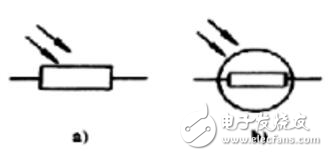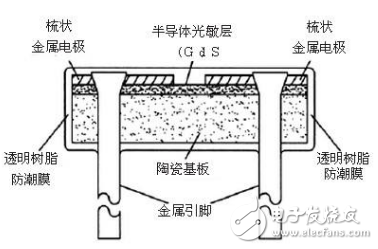Photoresistors are also known as light pipes. Commonly used materials are cadmium sulfide. In addition, there are materials such as selenium, aluminum sulfide, lead sulfide, and bismuth sulfide. These materials have the characteristic that their resistance decreases rapidly under the irradiation of light of a specific wavelength. This is because the carriers generated by the light are involved in conduction and drift under the action of the applied electric field. The electrons rush to the positive pole of the power supply, and the holes rush to the negative pole of the power supply, so that the resistance of the photoresistor drops rapidly. Photoresistors are special resistors made of semiconductor materials such as sulfide barrier or selenide barrier. The photoresistor is a semiconductor photosensitive device. In addition to its high sensitivity, fast response speed, spectral characteristics and good R value consistency, it can be used at high temperatures. , It can maintain a high degree of stability and reliability in the harsh environment of high humidity. It can be widely used in cameras, solar garden lights, lawn lights, currency detectors, quartz clocks, music cups, gift boxes, mini night lights, light and sound control switches , Street lamp automatic switch and various light-controlled toys, light-controlled lighting, lamps and other light automatic switch control fields. The photoresistor is a kind of light-sensitive element, and its resistance value can change with the intensity of external light. The photoresistor is represented by the letters "R" or "RL" and "RG" in the circuit. The figure below shows the circuit symbol. Figure A shows the new symbol, and Figure B shows the old symbol. The working principle of photoresistor is based on the internal photoelectric effect. Electrode leads are installed at both ends of the semiconductor photosensitive material and packaged in a tube case with a transparent window to form a photosensitive resistor. In order to increase sensitivity, the two electrodes are often made into a comb shape. The materials used to make photoresistors are mainly metal sulfides, selenides and tellurides and other semiconductors. Usually, coating, spraying, sintering and other methods are used to make a very thin photoresistor body and comb-shaped ohmic electrode on an insulating substrate, connect the lead, and encapsulate it in a sealed housing with a transparent mirror to prevent the sensitivity from being affected by moisture. After the incident light disappears, the electron-hole pairs generated by the photon excitation will recombine, and the resistance of the photoresistor will return to its original value. A voltage is applied to the metal electrodes at both ends of the photoresistor, and there is a current passing through it. It will become larger with the increase of light intensity, thus realizing photoelectric conversion. The photoresistor has no polarity and is purely a resistive device. Both DC voltage and AC voltage can be applied during use. The conductivity of a semiconductor depends on the number of carriers in the conduction band of the semiconductor. Photoresistor is a kind of resistor made by the photoelectric effect of semiconductor, whose resistance value changes with the intensity of incident light. Mainly used for light measurement, light control, and photoelectric conversion. Photoresistors are all made into a thin sheet structure to be able to absorb more light energy. The characteristic of this type of resistor is that the stronger the incident light, the smaller the resistance value, and the weaker the incident light, the greater the resistance value. For example, a photoresistor is used in the sound control lamp as a device to control the light during the day. The structure of photosensitive resistance: usually composed of photosensitive layer, glass substrate and electrodes. Shading detection. When testing, set the multimeter to resistance K level, and use a piece of black paper to cover the light-transmitting window of the photoresistor. At this time, the pointer of the multimeter basically remains unchanged. The resistance value is close to infinity. The larger the value, the performance of the photoresistor is indicated. The better. If this value is very small or close to zero, it means that the photoresistor has been burned out and cannot be used. Detect the light. Aim a light source at the light-transmitting window of the photoresistor, at this time the pointer of the multimeter should swing by a large margin, and the resistance value is obviously reduced. The smaller the value, the better the performance of the photoresistor. If the value is large or even infinite, it means that the internal open circuit of the photoresistor is damaged and cannot be used. Flash detection. Aim the light-transmitting window of the photoresistor at the incident light, and shake the upper part of the light-shielding window of the photoresistor with a black piece of paper to make it intermittently receiving light. At this time, the pointer of the multimeter should swing left and right with the shaking of the black piece of paper. If the pointer of the multimeter always stops Do not swing with the shaking of the paper at a certain position, indicating that the photoresistor has been damaged. Next, we use a digital multimeter to measure the quality of the photoresistor. First, set the multimeter to the resistance range of 20K. Because the photoresistor has no positive and negative poles, the red and black test leads are randomly connected to the two ends of the photosensitive. The multimeter shows a resistance value of 0.86 kohms, and then shield the photosensitive area with your hand to change it. The intensity of the light, the resistance value displayed by the multimeter is about 9.5 kiloohms, and the resistance value has obvious changes, indicating that the photoresistor is good. If the resistance does not change, the photosensitive is bad.
HIGH QUALITY:Made of only the highest quality materials and built to last! Our chargers are gauranteed to match the original brand name chargers' quality.
EASY TO USE: Simply plug the charger into a wall outlet and then directly into your scooter.
The charger protected: Short circuit protection/ over current protection/ over voltage protection; red light -- charging, green light -- charge OK, it stop automatically when the battery is full. Warm Tips: To avoid the temperature of your charger too high, please do not charge too long.
Aviation Plug Scooter Charger,Power Scooter Charger,Li-Ion Battery Charger Shenzhen Waweis Technology Co., Ltd. , https://www.waweis.com

The basic principle of photoresistor
var videoObject = {container:'.video', variable:'player', autoplay: true, html5m3u8: true, video: "https://vdse.bdstatic.com//21968f7d3fd9f4f839dcbed7e3e06fcd?authorization=bce-auth-v1%2Ffbe297a5cc0fb8103c9717b434c971 %2F2017-05-11T09%3A02%3A31Z%2F-1%2F%2F2a852ee0b73c576b9753c5c27c612f5c9eaf75251957a331774de59ceeb14c90" }; if (!! window.ActiveXObject) {videoObject.html5m3u8 = false} var player = new videoObject.html5m3u8 = false} var player